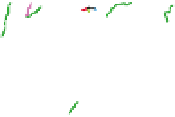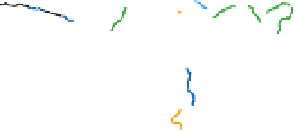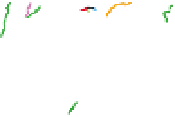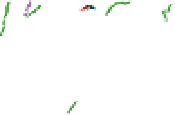Geography Reference
In-Depth Information
Riparian forest removal on the Drôme
tributaries located near Saillans
1948 typology
Actual typology
l
N
30
1.03
22%
1.67
70%
1.74
65%
km
Riparian forest removal in the upstream
sections of the Roanne tributary
Riparian forest removal on the Drôme
tributaries located downstream of the Bez
Extreme context in which riparian forest
removal is applied on the three areas
1.78
1.76
1.83
66%
62%
54%
Types with high % length of valuable habitats
(Covered by canopy and braided reaches)
Functional reach types
70%
Upland V-shaped valley reaches
Gravel bars
Gorges
Alternating gravel bars and
reaches covered by the canopy
1.67
Shannon index
Meandering / wandering transition
Braided reaches
Riparian forest removal near Saillans
Riparian forest removal along the Roanne tributary
Riparian forest removal downstream the Bez tributary
Covered by canopy
Upland meandering
Embanked reaches
Figure 11.10
Sensitivity of functional reach type diversity as a proxy of habitat diversity to changes following sediment reintroduction
(Bertrand and Piegay, unpublished data). A few situations are shown: the present state, the 1948 state calculated retrospectively, three
management options (forest removal along tributaries near Saillans, along the Roanne tributary and downstream the Bez tributary)
and an extreme option that combines the three basic options. Two indices are also calculated : the Shannon index based on the
functional reach type frequency and the percentage of the network length occupied by braided and canopy covered reaches.
(in roughly down-channel order): ''covered by canopy''
and ''alterning gravel bars and canopy covered'' become
''gravel bar reaches'', and, further downstream, ''mean-
dering/wandering transition reaches'' becomes ''braided''
reaches. Shannon index was then calculated based on the
relative length of geomorphic types for the present state
and after applying sediment reactivation in different sub-
catchment areas. The procedure underlines that whatever
the reactivation option, the changes in geomorphic types
have positive consequences in term of functional reach
type diversity at the network scale even in the case of the
most ambitious scenario of reactivation (H
=
1.67 in the
present state against 1.74 to 1.83 for the different scenar-
ios) (Figure 11.10). When using another habitat diversity
proxy, such as the % length of valuable habitats consider-
ing only reaches covered by canopy and braided reaches,
the sensitivity analysis reveals that the reactivation has
negative effects in terms of habitat diversity.
11.4.3 Inter-reach comparisons at a network scale
This third applied example focuses on the braided chan-
nel reaches of the Rh one basin (Figure 11.11). It is based
on detailed case-studies from Piegay et al. (2009) and
Belletti et al. (2010). The question of interest to water
managers in charge of implementing the WFD is whether
site-specific restoration or conservation programs can
be developed for braided rivers based on the spatial
variability of their planform properties and dynamics.
There are two basic scales of analysis useful for answer-
ing the basic broad management question: (i) the scale
of the active channel itself defined as the corridor of gravel





























































































































































































































































































































































































































































Search WWH ::

Custom Search